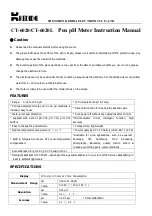
IOM BiRotor Plus R19
Page 13/37
8.2 - Installing the Instrument
1. Remove the inlet and outlet protection covers.
2. Install the instrument into the pipe work us-
ing suitable hardware as specifi ed in the local
codes and regulations. Ensure that the connec-
tions are made tight and torqued to the correct
values.
3. Connect the instrument wiring, refer to Figures
9-1 and 9-2. Cable entry into the electrical en-
closure is by two 3/4-14 NPT female threads.
4. Use wiring appropriate for the location and
operating conditions. Wiring glands and/or
conduits must conform to local electrical codes
and regulations if wiring is to be installed in a
hazardous area.
NOTE:
For additional requirements on installation please
refer to Chapter 2, Essential Instructions, at the
beginning of this manual.
If the instrument is being installed with additonal
accessories, the instructions for those accessories
should be read and understood before continu-
ing with the installation. The output signal from
the preamplifi er, if one is fi tted, can be altered to
interface with most electronic accessories. This is
accomplished by the use of jumpers on the circuit
board. Refer to Figure 8-1 for their confi gurations.
The UMB housing may be rotated in 90°
increments to accomodate the mounting of
accessories. If the UMB housing is removed for
any reason, care must be taken to disconnect the
sensor wires to prevent sensor damage. It is
essential that the four retaining screws used to
secure the UMB housing to the meter body be
torqued to 55 in/lbs.
Internal grounding terminal must be used for the
equipment grounding connection, and the external
terminal is for supplementary bonding connection.
Figure 8-1 Wiring Connections
TB1
Function
1
9-28 VDC Supply
2
V Comm
3
Channel A Signal
4
Channel A and B Common
5
Channel B Signal
Jumper
Position
J1 (Channel A)
B
1
J2 (Channel B)
B
1
5 VDC Pulse
V Supply Pulse
2
J3 (Channel A)
A
B
J4 (Channel B)
A
B
NOTE:
1
Do not Change without consulting factory.
2
V Supply Pulse = Input V minus approximately 2 volts
The instrument should not be located in a location
where excessive vibration is to be expected.
Care should be taken not to locate the instrument
near any source of electromagnetic interference,
such as those produced by electric motors, trans-
formers, solenoids, etc.
Either of these factors could induce a signal into
the fl ow sensing pickoff and interfere with the
accuracy of line product measurement.
Summary of Contents for BiRotor Plus B27X
Page 27: ...IOM BiRotor Plus R19 Page 27 37 12 1 BiRotor Plus Illustrated Parts List...
Page 31: ...IOM BiRotor Plus R19 Page 31 37 12 2 BiRotor Plus Illustrated Parts List B3XX...
Page 32: ...Page 32 37 IOM BiRotor Plus R19 12 3 BiRotor Plus Illustrated Parts List B3XX...














































